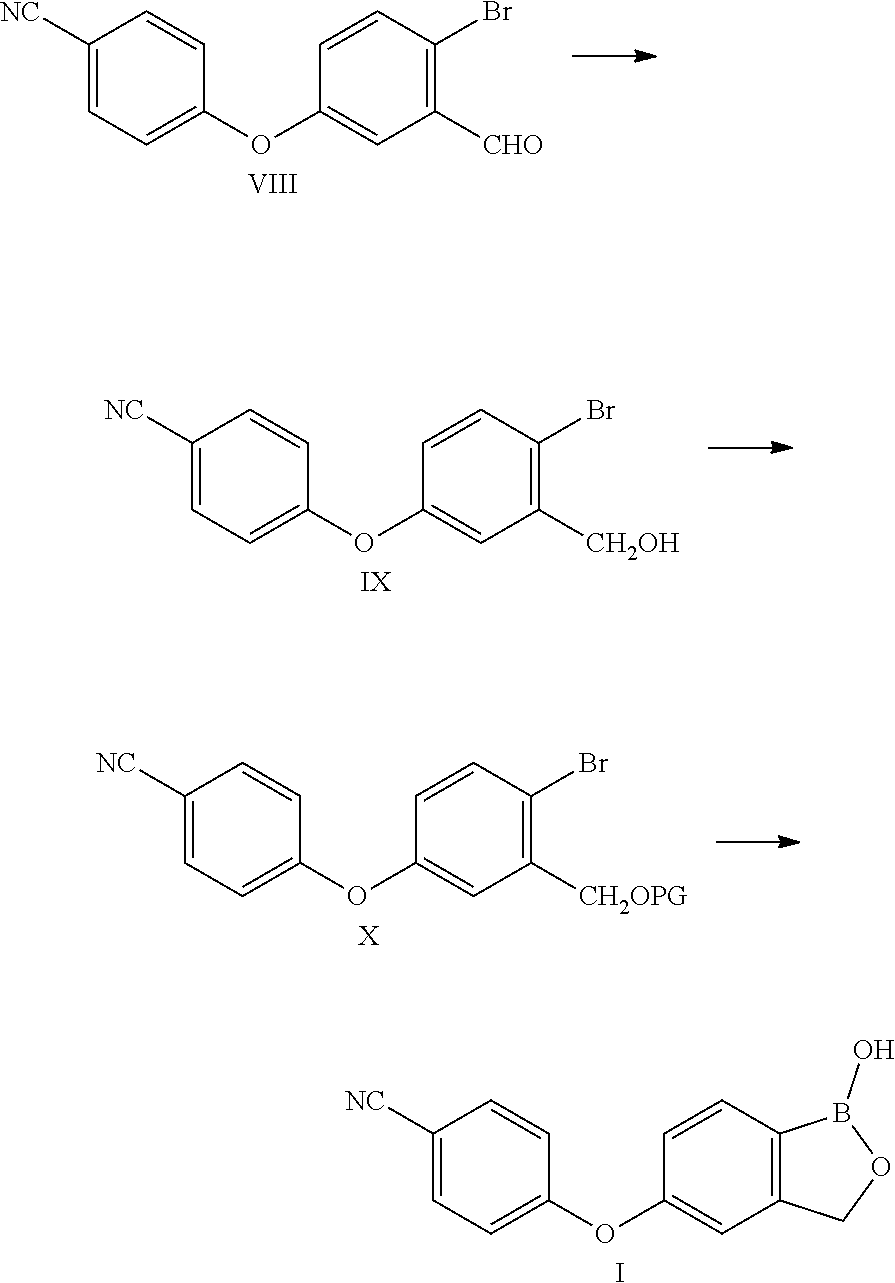Method for preparing Crisaborole
a boron-containing, heterocyclic compound technology, applied in the field of organic chemistry, can solve the problems of low yield, unsuitable industrial production, and yield only 33%
- Summary
- Abstract
- Description
- Claims
- Application Information
AI Technical Summary
Benefits of technology
Problems solved by technology
Method used
Image
Examples
example 1
Preparation of 4-iodo-3-methyl-phenol (Compound of Formula VI)
[0094]
[0095]A flask was charged with 40 g m-methylphenol (0.37 mol), 180 ml acetonitrile and 0.5 g p-toluenesulfonic acid. After cooled to 10° C.˜15° C., 92 g NIS (0.41 mol) was added in bateches to the flask under stirring. The temperature of the reaction system was controlled at 10° C.˜15° C. After reacting for 12 hours, 50 ml 5% sodium bisulfite aqueous solution was added to the flask, and stirred for 1 hour. The reaction solution was distilled under reduced pressure to remove most of acetonitrile. 100 ml dichloromethane was added to the residue, stirred, and then allowed to separate into layers. The organic layer was concentrated by vacuum distillation. The residue was added into 200 ml water to precipitate light yellow solid. After stirring for 2 hours, filtration and drying yielded 76 g target product with purity of 98.3% and yield of 87.7%.
[0096]Mass: m / z 232.8 [M−H]+;
[0097]1H NMR (400 MHz, CDCl3) δ 7.62 (d, J=8.4 ...
example 2
Preparation of 4-bromo-3-methylphenol (Compound of Formula VI)
[0098]
[0099]A flask was charged with 40 g m-methylphenol (0.37 mol) and 200 ml dichloromethane. After cooled to 0° C.˜5° C., 169 g 1,3-dibromo-5,5-dimethylhydantoin (0.59 mol) was added in batches to the flask under stirring.
[0100]The temperature of the reaction system was controlled at 30° C.˜35° C. After reacting for 8 hours, 50 ml 5% sodium bisulfite aqueous solution was added to the flask, and stirred for 1 hour. The reaction solution was distilled under reduced pressure to remove most of dichloromethane. 100 ml dichloromethane was added to the residue, stirred, and allowed to separate into layers. The organic layer was concentrated under reduced pressure. The residue was added into 200 ml water to precipitate light yellow solid. After stirring for 2 hours, filtration and drying yielded 57 g target product with purity of 97% and yield of 83%.
[0101]Mass: m / z 184.9 [M−H]+;
[0102]1H NMR (400 MHz, CDCl3) δ 7.60 (d, J=8.4 H...
example 3
Preparation of 4-bromo-3-methylphenol (Compound of Formula VI)
[0103]
[0104]A flask was charged with 40 g m-methylphenol (0.37 mol), 200 ml ethyl acetate, 39 g hydrobromic acid (0.48 mol) and 37 g dimethyl sulfoxide (0.48 mol). The system was stirred, heated to 60° C.˜65° C. and reacted at the temperature for 3 hours. After cooled to room temperature, 200 ml 10% sodium bisulfite aqueous solution was added to the flask, and then allowed to separate into layers. The organic layer was concentrated under reduced pressure. The residue was added into 200 ml water to precipitate light yellow solid. After stirring for 2 hours, filtration and drying yielded 62 g target product with purity of 98% and yield of 90%.
[0105]Mass: m / z 184.9 [M−H]+;
[0106]1H NMR (400 MHz, CDCl3) δ 7.60 (d, J=8.4 Hz, 1H), 6.72 (d, J=3.2 Hz, 1H), 6.41 (dd, J1=2.8 Hz, J2=8.4 Hz, 1H), 4.80 (s, 1H), 2.34 (s, 3H).
PUM
| Property | Measurement | Unit |
|---|---|---|
| temperature | aaaaa | aaaaa |
| reaction temperature | aaaaa | aaaaa |
| temperature | aaaaa | aaaaa |
Abstract
Description
Claims
Application Information
 Login to View More
Login to View More - R&D
- Intellectual Property
- Life Sciences
- Materials
- Tech Scout
- Unparalleled Data Quality
- Higher Quality Content
- 60% Fewer Hallucinations
Browse by: Latest US Patents, China's latest patents, Technical Efficacy Thesaurus, Application Domain, Technology Topic, Popular Technical Reports.
© 2025 PatSnap. All rights reserved.Legal|Privacy policy|Modern Slavery Act Transparency Statement|Sitemap|About US| Contact US: help@patsnap.com



